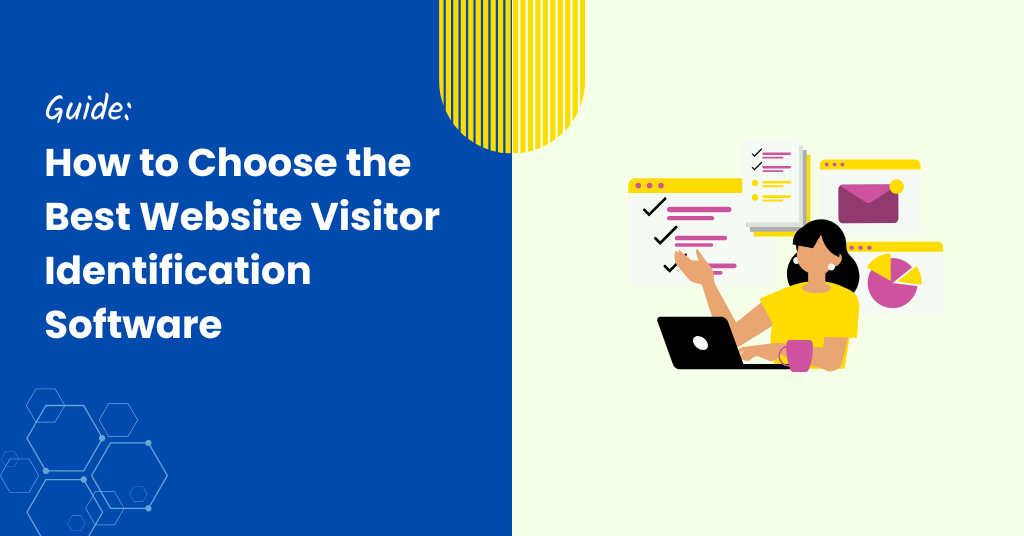Picture this: You’re running a killer promotion, your Facebook ads are on fire, and traffic is pouring into your site. But there’s one problem—those visitors are ghosting you before they even drop an email or hit “buy.” Frustrating, right?
Even worse — 60% of marketers aren’t using website visitor identification software to determine who those people are. That’s a massive opportunity just slipping away!
But not for companies like Harvest Hosts. They plugged in a visitor identification tool and added 74,000 emails to their list, saw $125k in annual recurring membership revenue, and boosted their email revenue by 35%. Yeah, you read that right.
This software is a big deal for ecommerce brands!
If you’re ready to stop watching anonymous shoppers disappear into the digital abyss, let’s dive into how website visitor identification software can turn those “who-was-that” moments into cold, hard revenue.
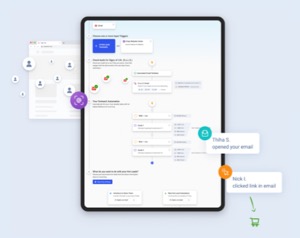
See Who Is On Your Site Right Now!
Get names, emails, phone numbers & more.
Try it Free, No Credit Card Required
What is Website Visitor Identification Software?
Website visitor identification software is a tool that reveals the identity of anonymous visitors who land on your site.
Instead of wondering who’s browsing without signing up or buying, this software tracks visitor behavior, matches it with databases, and gives you details like names, email addresses, and even companies they work for.
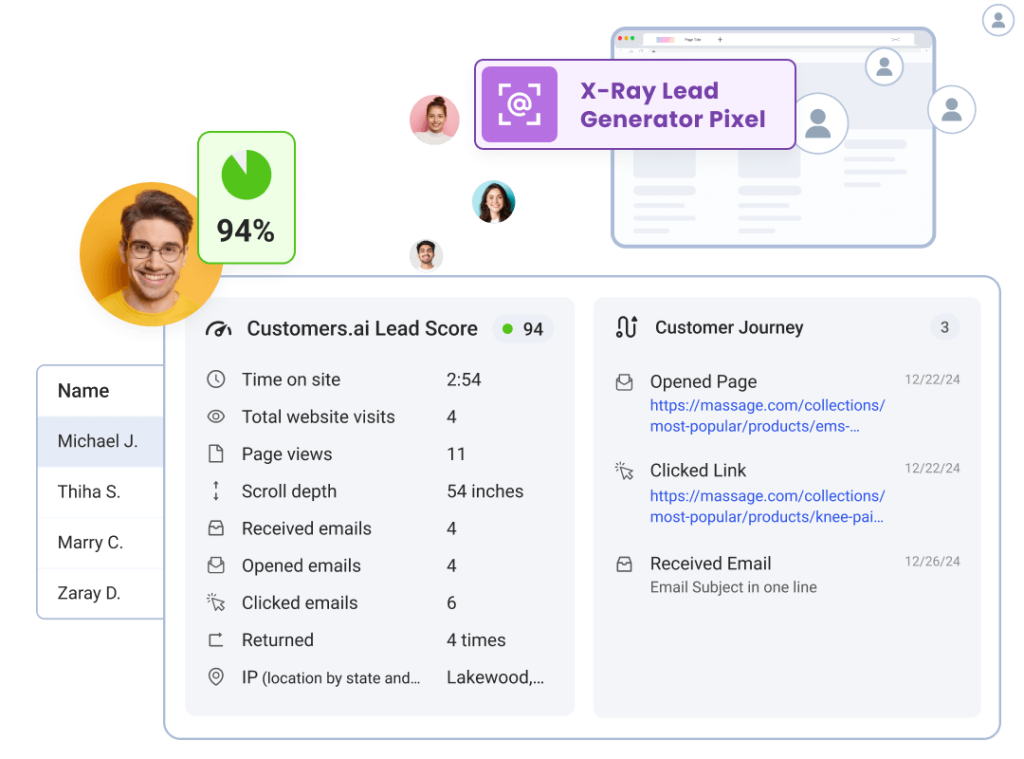
With more than 90% of website visitors leaving without a trace, website visitor identification software helps you turn mystery clicks into real, actionable leads. Whether someone is eyeing your products or has abandoned their cart, this software makes sure you know who they are and how to re-engage them.
The best part? For DTC brands, this means you can finally stop missing out on key customer info and start capturing those shoppers to drive sales, boost email lists, and reduce that pesky cart abandonment problem.

Why Do You Need Website Visitor Identification Software?
Understanding why your DTC brand needs website visitor identification software boils down to some hard truths about how people shop online.

Here are five key reasons:
1. 90% of Visitors Don’t Give You Their Information
Most visitors browse your site without ever filling out a form or signing up for emails, leaving you in the dark about who they are.
Without visitor identification software, you’re missing out on valuable customer info that could turn browsers into buyers.
2. Cookies Are Losing Their Power
With browsers like Safari and Firefox phasing out third-party cookies and Klaviyo’s cookies only lasting 7 days, relying on old tracking methods is becoming less effective.
Visitor identification software uses a number of data points to capture visitor behavior and details in real-time, giving you a reliable way to track and engage with your audience—even after cookies expire.
3. 70% of Users Abandon Their Cart
Cart abandonment is a major issue for ecommerce. Without the ability to identify who these shoppers are, you’re left with little to no chance of recovering those lost sales.
Visitor identification gives you the insight to re-engage those customers effectively.
4. Buying Takes Multiple Touchpoints
Today’s shoppers don’t convert after just one interaction – it can take 6-8 touchpoints before a visitor finally makes a purchase.
Without visitor identification software, tracking those multi-channel touchpoints—whether through ads, emails, or on-site behavior—becomes nearly impossible, making it harder to nurture potential buyers through the full customer journey.
5. Visitors Who Return Are More Likely to Buy
Did you know that visitors who return to your site are 2-3 times more likely to convert than first-time visitors?
Visitor identification software helps you identify these high-potential return visitors, allowing you to create targeted campaigns that close the deal, turning interest into sales.
The fact of the matter is, there are plenty of reasons why ecommerce businesses should be using website visitor identification software and if they aren’t, some big misses are happening.

Key Features to Look for in Website Visitor Identification Software
Anyone who has worked with marketing software knows that not all tools are created equal and that is certainly the case with website visitor identification software.
To make sure you’re finding the right software for your business, here are 10 key features to keep an eye out for:
1. ESP & CRM Integrations
No one wants their tech stack to get more complicated. That’s why your website visitor identification software should seamlessly integrate with tools like Klaviyo, Shopify, and Mailchimp—the platforms you’re already using.
It should complement your workflow, not disrupt it.
With the right integrations, you can sync data automatically, trigger personalized emails, and keep your marketing running smoothly without any extra hassle.
2. Ads Integrations
Retargeting is one of the most effective ways to convert visitors who didn’t buy on their first visit. With the right ads integrations, you can retarget potential customers across channels like Facebook and Google, giving you another chance to bring them back to your site.

Plus, having a direct integration keeps your data secure, ensuring your campaigns are both efficient and privacy-compliant.
And here’s a bonus: Customers.ai is the only official Meta partner in this space, giving you an edge over the competition when it comes to running high-precision retargeting campaigns.
3. Customer Journey Tracking
Most visitor identification tools stop at just collecting data, but what about understanding how visitors interact with your site before they convert?
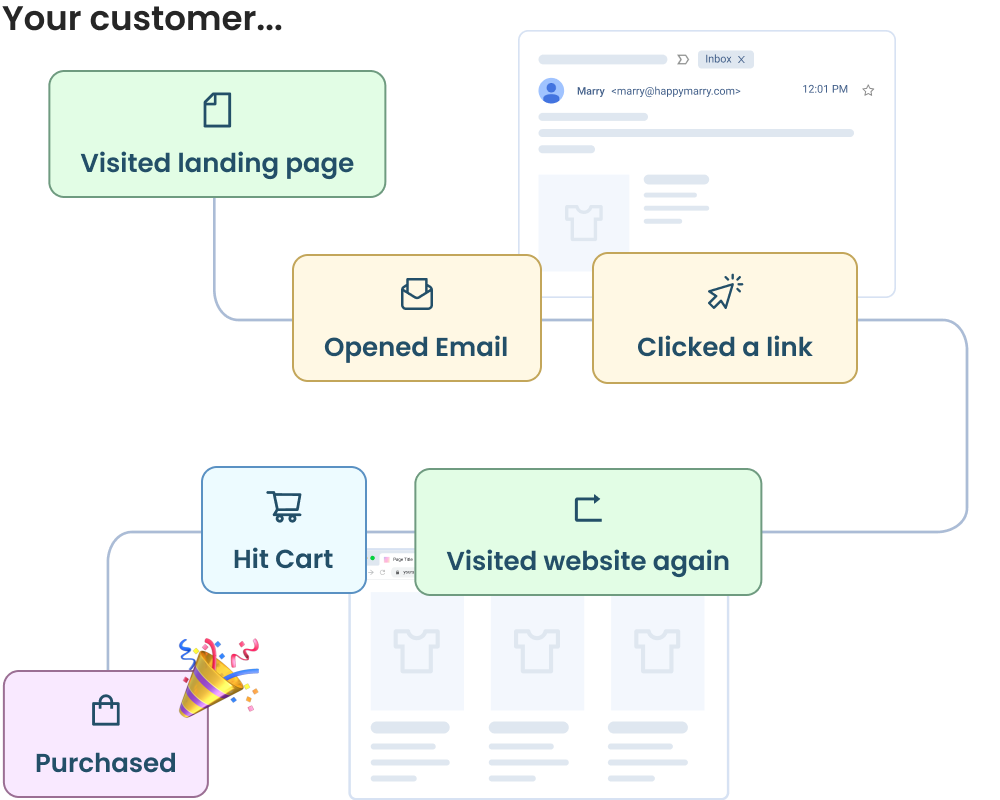
That’s where customer journey tracking comes in. This feature lets you see the entire path a visitor takes, from their first click to checkout (or even abandonment), so you can fine-tune every step of the process.
Few tools offer this kind of visibility, making it easier for you to optimize touchpoints and turn more browsers into buyers.
4. Customer Support with Ecommerce Expertise
When things go wrong or you need advice, having a support team that truly understands your business and industry is crucial. For ecommerce brands, it’s not just about fixing issues—it’s about getting the right guidance to optimize campaigns, improve conversions, and maximize the tools you already use.
A team with deep knowledge of platforms like Shopify and Klaviyo can make all the difference in ensuring smooth operations. The team here at Customers.ai is trained and certified in both, meaning you’ll get expert help from people who know your space.
5. First-Party Data Collection
While website visitor identification software excels at using third-party data to reveal who’s visiting your site, the real power comes from integrating it with your first-party platforms (think Saleforce or Klaviyo).
By combining this software with the data you’re already collecting, you can enrich your contacts with more accurate, detailed information—giving you a fuller picture of your visitors.
6. ROI Reporting
If you’re investing in tools, you want to know they’re making you money. That’s where ROI reporting comes in.

The best website visitor identification software should show you exactly how much revenue it’s helping you generate. By tracking the leads it captures and the conversions it drives, you can easily see the impact on your bottom line.
7. Segmentation and Audience Targeting
The right website visitor identification software lets you create highly targeted campaigns that speak directly to each segment—whether it’s first-time browsers or repeat shoppers.
With segmentation and audience targeting, you can group visitors based on their behavior, interests, or where they are in the buying journey, giving you more precision and a better customer experience.
8. Email Deliverability Tools
Sending emails is one thing—getting them into your customers’ inboxes is another. It’s essential that email deliverability tools are built into your website visitor identification software so you can ensure that the emails you send actually make it to the inbox, not the spam folder.
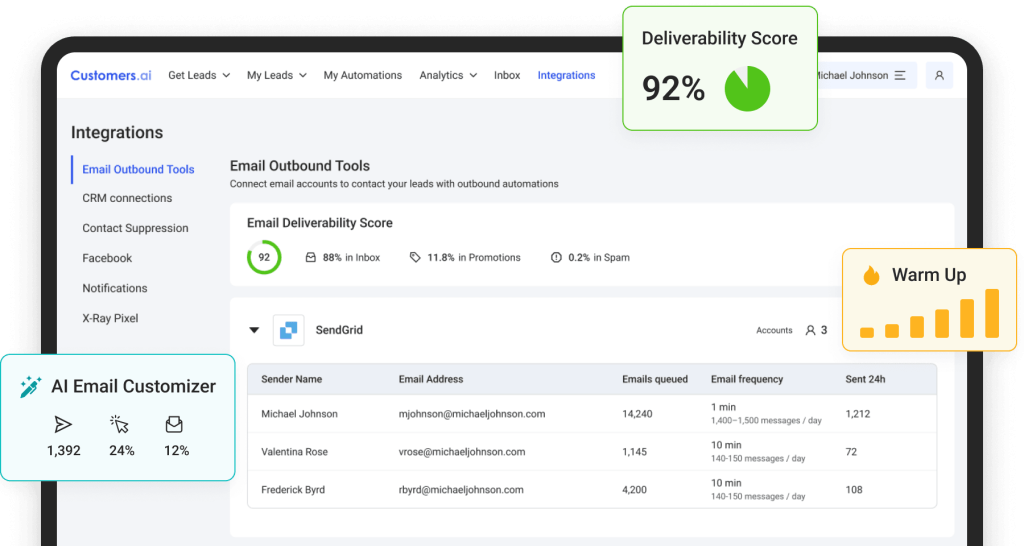
These tools optimize your email deliverability by using clean, verified data and following best practices.
9. Data Enrichment Tools
Capturing a name and email is cool, but that’s just scratching the surface. With data enrichment tools, you can dig deeper and add extra details—like job titles, company info, or purchase history—that give you a fuller picture of who your visitors really are.
The key it to build rich profiles that help you market smarter and make your messaging more personal. When you know more, you can do more.
10. Multi-Channel Attribution & Visitor Tracking
Your customers interact with your brand across multiple channels, and the right website visitor identification software makes sure you know exactly where they’re coming from.
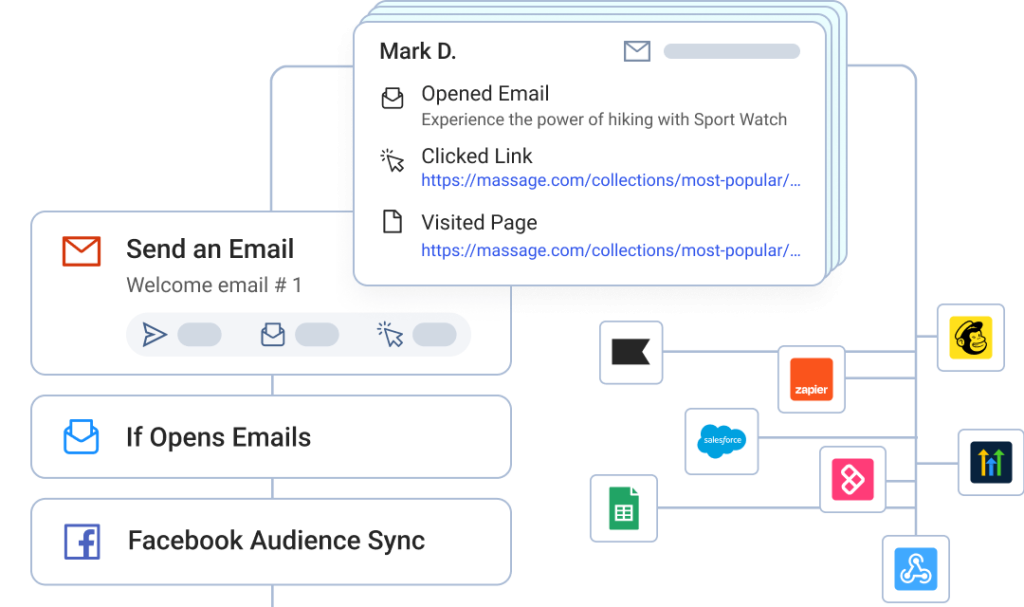
With multi-channel attribution and visitor tracking, you can see if visitors arrived via Facebook, Google, email, or another source. This feature helps you track their journey, so you know which channels are driving the most conversions.
These key features will help you get the most out of your website visitor identification software, from better understanding your customers to boosting conversions.
Remember, when it comes to website visitor identification software it’s not just about the data, but how you can use that data.

See Who Is On Your Site Right Now!
Get names, emails, phone numbers & more.
Try it Free, No Credit Card Required

Types of Website Visitor Identification Software
When people hear “website visitor identification software,” they might scratch their heads, wondering what it actually does.
The truth is, there are a bunch of different tools that could fall into this category, each helping you understand who’s browsing your site in their own way.
Whether it’s tracking behavior, resolving identities, or capturing data, these tools work together to give you the full picture of your visitors. Let’s break down the different types you might come across.
Website Visitor ID Tools
Website visitor ID tools, like Customers.ai, are all about uncovering who’s actually visiting your site, even if they haven’t signed up or made a purchase.
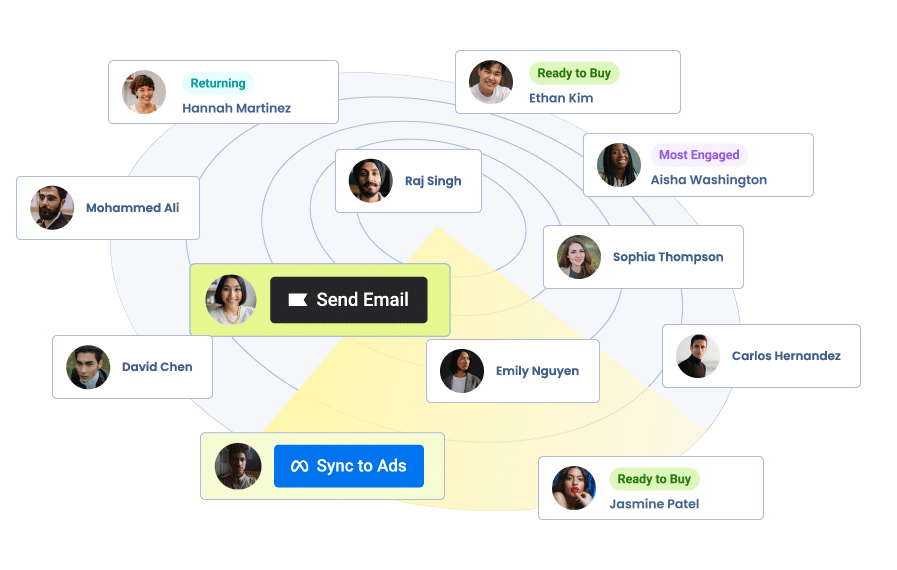
These tools work by tracking visitor behavior and matching it with available data to give you key details like names or emails.
This is super useful for DTC brands looking to connect with high-intent visitors or retarget potential customers across different platforms. It’s all about knowing who’s interested in your brand and how to re-engage them effectively.
IP Address Tracking Tools
IP address tracking tools work by identifying the IP addresses of your site visitors, which can give you a rough idea of where they’re located or even the company they work for.
Historically, this was useful for targeting visitors from certain regions or specific businesses. But these days, with so many people working remotely, the data isn’t as reliable. For ecommerce brands, it’s often too broad and doesn’t offer the personal insights needed to really connect with individual shoppers.
Identity Resolution Platforms
Identity resolution platforms are all about connecting the dots. These tools take data from various sources—like cookies, email interactions, and even social media—and match it to a single user profile.
For ecommerce brands, this means you can track a visitor’s journey across devices and sessions, creating a clearer picture of who they are.
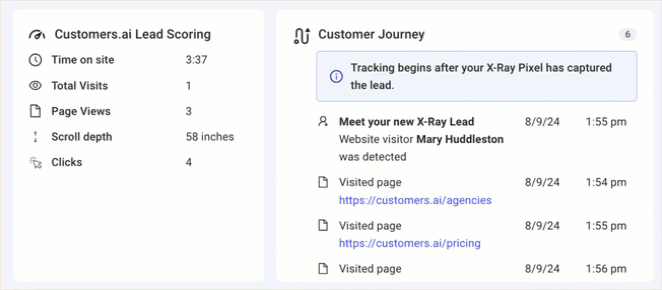
The upside? It helps you move beyond anonymous traffic and gives you the ability to personalize your marketing. However, with privacy concerns growing and third-party cookies on the decline, these platforms are evolving to rely more on first-party data.
Behavioral Tracking Software
Behavioral tracking software helps you understand what visitors are doing on your site—what pages they visit, how long they stay, what they click on, and even when they leave.
For ecommerce brands, this is gold. You can use this data to see which products are getting the most attention, spot friction points in the buying process, and tailor your site to improve the customer experience.
On-Site Form and Popup Captures
On-site forms and popups are classic tools for capturing visitor information while they’re actively engaging with your site. Whether it’s offering a discount for signing up or prompting users to share their email before they leave, these tools help turn anonymous traffic into actual contacts.

For ecommerce brands, well-timed forms and popups can be a great way to capture leads, reduce cart abandonment, and boost conversions.
Customer Data Platforms (CDPs)
Customer Data Platforms (CDPs) bring all your customer data together in one place. They collect information from different touchpoints—like your website, email campaigns, and social media—and create unified profiles for each customer.
For ecommerce brands, this means you can track the entire customer journey, segment audiences, and deliver more personalized marketing. With a CDP, you get a 360-degree view of your customers
Website Analytics Tools
Most people are familiar with Google Analytics, the largest analytics tool provider. Website analytics tools show you how visitors are interacting with your site. Think metrics like traffic, bounce rates, session duration, and conversion rates, helping you understand what’s working and what’s not.

While analytics tools don’t provide personal details about visitors, they offer insights into overall site performance and visitor behavior trends.
With so many types, the lines can get a little blurry when it comes to website visitor identification software. Hopefully, this breakdown makes it clearer for marketers looking to choose the right tools.

How Website Visitor Identification Software Works
Every visitor who lands on your site leaves behind a digital footprint—whether they realize it or not.
This footprint includes things like the pages they visit, how long they stay, and their IP address. Website visitor identification software picks up on these subtle clues and pieces them together, using data from third-party sources and your own systems to create a more complete picture of who’s browsing.
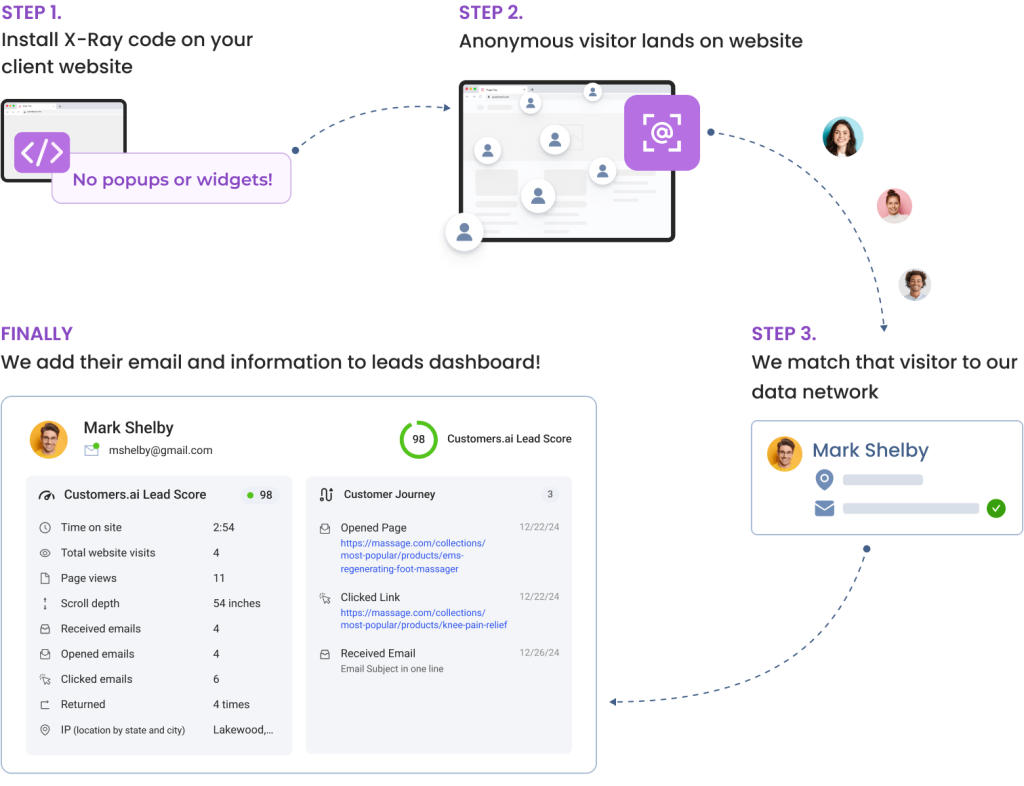
The process goes something like this: the software tracks user behavior, cross-references it with third-party databases, and combines it with tools like cookies and CRM integrations.
Instead of relying on visitors to fill out a form, the software is quietly working behind the scenes to give you valuable insights—like names, emails, and even purchase intent.
What does that mean for your brand?
It means you can act faster, personalizing your marketing to those visitors while they’re still hot.
You can target them with ads, follow up with personalized emails, or create tailored offers that speak directly to their browsing behavior.

Top Benefits of Using Website Visitor Identification Software
Curious how website visitor identification software can help your brand? Whether you’re trying to turn browsers into buyers or just stop customers from ghosting at checkout, here are five ways this tool can boost your ecommerce game.
1. Identify High-Intent Visitors
Instead of guessing who might be interested in your brand, website visitor identification software gives you real data on who’s actively browsing your site. For a DTC brand, this means you can capture details like email addresses or browsing behavior from high-intent visitors checking out specific products.
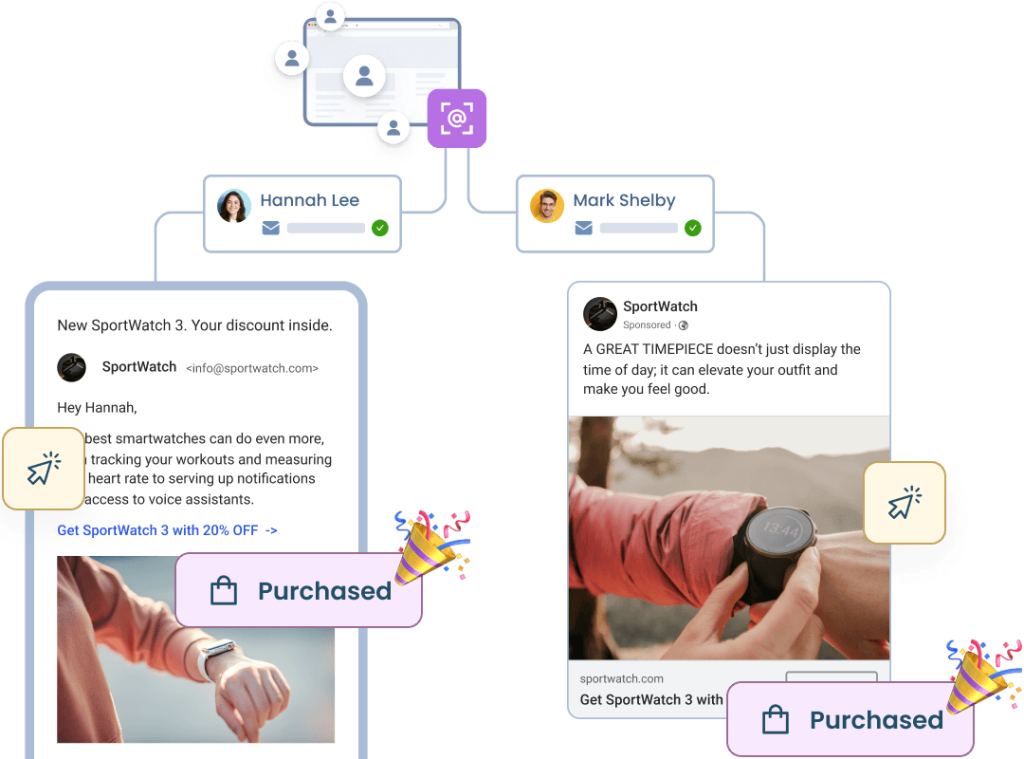
For example, if someone spends time on your new sneaker collection, you can send them targeted messaging or exclusive offers tailored to that interest, increasing the chances of conversion.
2. Boost Personalization
With visitor data in hand, you can create more tailored marketing experiences. For a DTC brand, this could mean sending personalized emails with product recommendations based on what a visitor was browsing.
Imagine a skincare brand knowing someone spent time looking at moisturizers—you could follow up with a custom email offering tips for hydration and a special offer on that very product.
3. Improve Retargeting Campaigns
Retargeting becomes way more powerful when you know exactly who you’re aiming for. For example, a DTC brand selling workout gear can retarget visitors who viewed specific product categories, like leggings or running shoes, with dynamic ads on Facebook or Google.
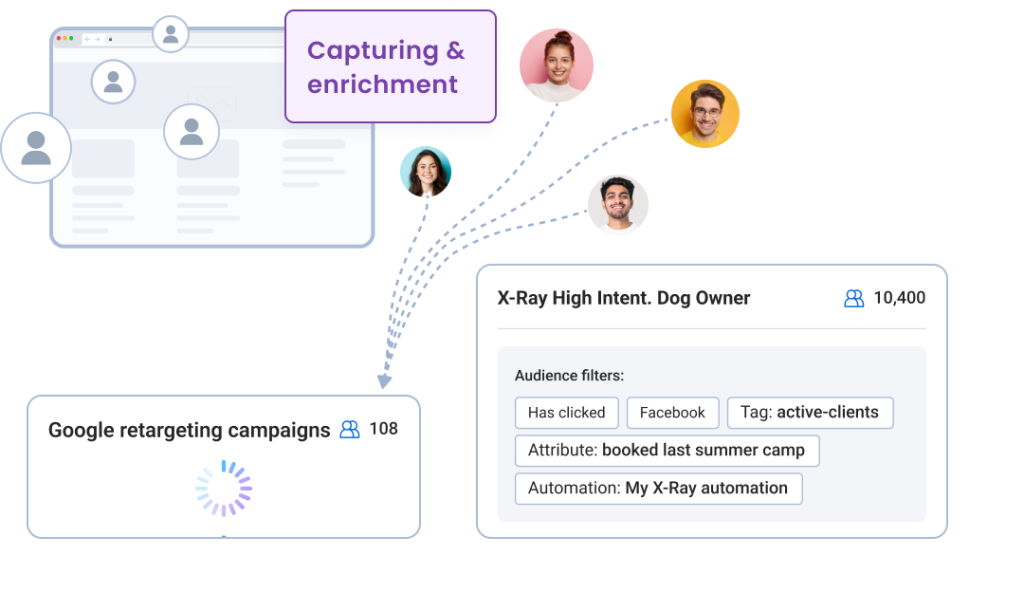
Instead of broad campaigns, you can laser-focus on those who’ve already shown interest, making your ad spend much more efficient and impactful.
4. Reduce Cart Abandonment
Cart abandonment is a big issue for ecommerce brands, but with website visitor identification software, you can track who’s leaving without purchasing and follow up.
For a DTC brand, this means sending targeted email reminders to visitors who added items to their cart but didn’t complete checkout—like that customer who left behind a $150 worth of beauty products.
You can bring them back with a simple “Don’t forget your cart!” nudge or even offer a small discount to close the sale.
5. Maximize Marketing ROI
By knowing who’s visiting your site and understanding their behavior, you can focus your marketing budget on what really works. A DTC fashion brand, for instance, could use this data to see which visitors are coming from Instagram ads versus Google search.
With that insight, you could double down on the channels bringing in the most high-intent traffic, ensuring every marketing dollar is spent where it matters most and driving higher returns.
At the end of the day, website visitor identification software gives you the info you need to take control of your customer journey. It’s all about making smarter moves that get real results for your brand.
See the Visitors Hiding on Your Site
Book a demo of Customers.ai’s U.S. website visitor identification, customer journey insights and remarketing platform to skyrocket conversions and sales.

Factors to Consider When Choosing Website Visitor Identification Software
When picking the right website visitor identification software for your brand, there are five key factors you’ll want to keep in mind:
1. Integration with Your Existing Tools
Your software should work seamlessly with the tools you’re already using, like Shopify, Klaviyo, or Google Analytics. The last thing you need is something that complicates your workflow. Make sure it fits into your current tech stack without a hassle.
2. Ease of Use and Setup
No one has time for complicated setups or confusing dashboards. Look for software that’s easy to install and intuitive to use, so you can start seeing results right away without a steep learning curve.
3. Data Privacy and Compliance
With growing privacy regulations, it’s crucial that your software complies with GDPR, CCPA, and other data protection laws. Make sure the platform you choose respects user privacy and keeps your data secure to avoid any legal headaches down the line.
4. Accuracy and Real-Time Data
You need software that delivers accurate, up-to-date information on your visitors. Real-time data ensures you’re always in the loop and able to take action when a high-intent visitor is browsing your site—before they move on.
5. Pricing and Scalability
Finally, think about pricing and scalability. As your brand grows, your software needs to keep up. Choose a solution that fits your budget now but can scale with your business as traffic and sales increase.
These are the core factors that will help you choose the best website visitor identification software for your brand.

Common Mistakes to Avoid When Using Website Visitor Identification Software
Even with the right tools in hand, there are a few pitfalls that can trip you up. Here’s what to watch out for:
Not Integrating with Your Existing Marketing Tools
A common mistake is not fully integrating the software with your CRM, email platform, or ad channels. For example, if you’re not syncing with Klaviyo, you’re missing out on the ability to build automated email flows based on visitor data.
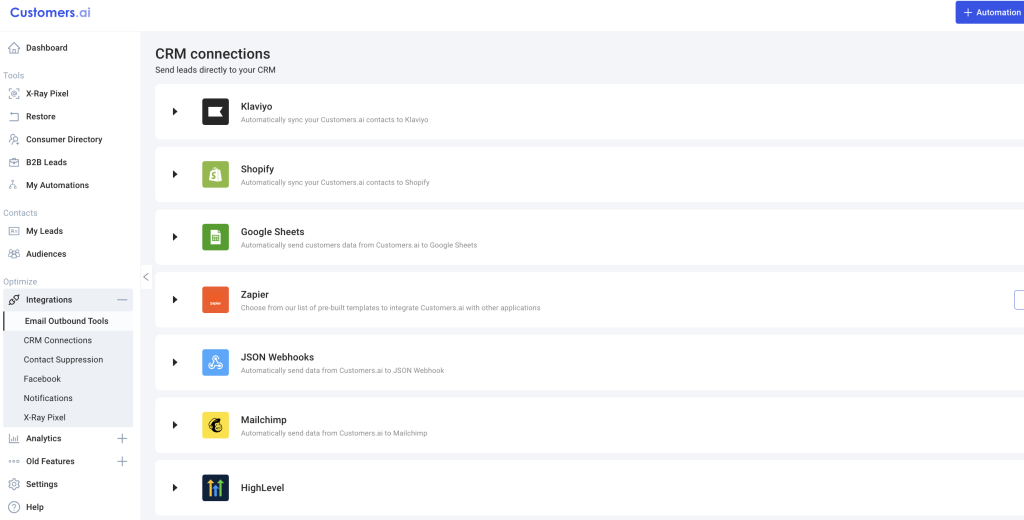
Key Tip: Make sure everything is connected to maximize the software’s potential.
Spamming All of Your Visitors
It might be tempting to email every visitor who provides their info, but that’s a fast track to getting marked as spam. Instead, focus on high-intent visitors—those who have shown real interest in your products by browsing multiple pages or adding items to their cart. Targeting these visitors with personalized emails will lead to better engagement and higher conversions.
Key Tip: Only email high-intent visitors to boost engagement and avoid spamming your audience.
Not Sending Your Data to Ad Platforms
Your customers are on multiple channels—Facebook, Instagram, Google, and beyond. If you’re not sending your visitor data to these platforms, you’re missing a huge opportunity to retarget them where they spend their time.
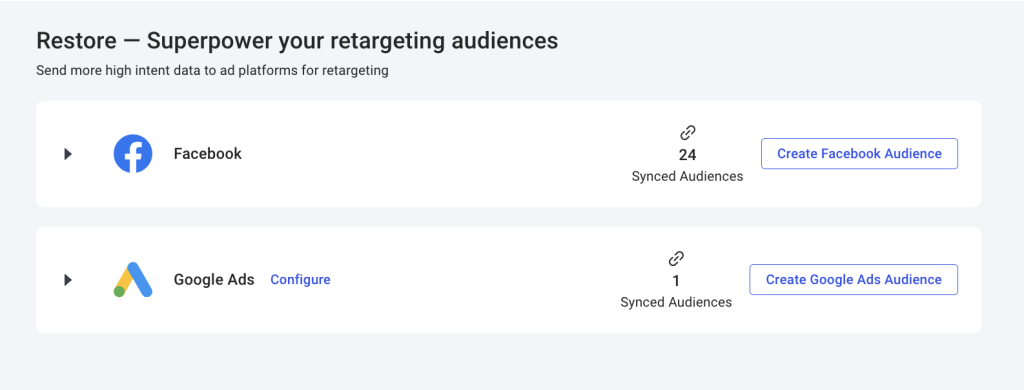
Key Tip: Send your visitor data to ad platforms so you can retarget customers across multiple channels.
Ignoring Real-Time Data
Not acting on real-time data is another missed opportunity. If a high-intent visitor is browsing your site and you’re not using that info to send a personalized email or serve a relevant ad, you’re leaving conversions on the table. Always make sure you’re leveraging real-time insights to engage visitors at the right moment.
Key Tip: Use real-time data to take action immediately and engage high-intent visitors when they’re most likely to convert.
Focusing on Quantity Over Quality
It’s easy to get caught up in gathering as much data as possible, but quality matters more than quantity. For example, collecting thousands of emails without segmenting or verifying them won’t help if they aren’t high-quality leads.
Key Tip: Focus on the quality of your data, not just quantity, to drive better conversions and engagement.

How to Implement Website Visitor Identification Software Successfully
Getting the most out of your website visitor identification software comes down to more than just plugging it in. Here’s how to set yourself up for success:
1. Choose the Right Tool for Your Needs
Make sure the software you pick fits seamlessly into your existing workflow and integrates with the tools you’re already using, like Shopify, Klaviyo, or Google Analytics. You want something that works with your tech stack—not against it.
2. Seamless Integration with Your Tech Stack
Fully integrating your visitor ID software with your CRM, email platform, and ad channels is key. This ensures you can track visitors across platforms, personalize your messaging, and create cohesive marketing campaigns that target high-intent shoppers.
3. Create Segmented Audiences
Once your software is up and running, use it to create segmented audiences based on behavior, intent, or shopping patterns. Think about targeting repeat visitors, cart abandoners, or people who’ve shown interest in specific products. This lets you tailor your marketing to what each group is most interested in.
4. Use the Data for Actionable Insights
It’s not enough to just gather data—you need to be able to use it. Whether it’s for retargeting ads, personalizing emails, or identifying which customers are ready to convert, make sure you have a strategy for turning visitor data into action.
5. Prioritize Data Privacy and Compliance
Be transparent with your visitors about how their data is being collected and used. Ensure your setup is compliant with GDPR, CCPA, and other privacy regulations, so your visitors feel secure sharing their information.
6. Leverage Customer Support
Don’t go it alone. Make use of the customer support offered by your software provider—especially if their team is knowledgeable about ecommerce. Whether you need help with setup or optimizing your campaigns, having expert support can make all the difference.
7. Test and Optimize
Keep track of how your visitor identification efforts are performing, and don’t be afraid to test new strategies. Adjust your messaging, experiment with different segments, or tweak your campaigns to see what drives the best results.
Easy enough right? Just think, by following these steps, you’ll be well on your way to making the most of your website visitor identification software.

Comparison of Popular Website Visitor Identification Software
There are several website visitor identification software tools on the market, each offering unique features for brands looking to get more out of their site traffic.
Here’s a quick look at some of the key players:
Customers.ai
Customers.ai is a comprehensive platform that helps ecommerce and DTC brands identify website visitors, track customer journeys, and retarget them across platforms like Facebook and Google. With advanced integrations, customer journey tracking, and direct access to first-party data, it’s designed to turn anonymous visitors into high-value customers.
Opensend
Opensend helps businesses identify anonymous visitors and capture data from their website traffic. However, it has faced challenges with segmentation, low capture rates, and occasional inaccuracies in the data it provides. While it offers basic identification tools, it lacks the advanced features needed for more precise targeting and robust visitor engagement compared to other platforms.
See how Opensend compares to Customers.ai.
Retention
Retention helps businesses track visitor data and use that information for personalized marketing campaigns. However, Retention recently shifted away from ecommerce to focus more on B2B companies, which makes it less suitable for DTC brands looking to identify and engage individual shoppers.
LeadFeeder
LeadFeeder is designed to help B2B companies identify visitors from specific businesses. It tracks IP addresses and connects the data to company profiles, making it ideal for account-based marketing strategies. However, it lacks robust individual visitor identification, focusing more on company-level data.
6sense
6sense is often thought of as a visitor identification tool, but it’s really more of an account-based marketing (ABM) platform. It focuses on identifying companies rather than individuals, making it less useful for brands that need to target specific people rather than broad accounts.
While these platforms offer valuable features, there are a few things they don’t do compared to Customers.ai:
- Direct Integration with Meta (Facebook): Unlike these platforms, Customers.ai is the only official Meta partner, giving you an edge when it comes to retargeting visitors across Facebook and Instagram with verified, real-time data.
- Customer Journey Tracking: Many tools focus only on identifying visitors, but Customers.ai goes a step further by providing full customer journey tracking, so you can see exactly how visitors engage with your site over time.
- Advanced First-Party Data Integration: Customers.ai excels at integrating with your first-party data from tools like Shopify and Klaviyo, ensuring your visitor data is enriched and actionable, whereas others rely heavily on third-party sources.
- All-in-One Capabilities: With Customers.ai, you don’t need to switch between multiple platforms to manage your visitor data, retargeting, and marketing campaigns. It’s all in one place, making it easier and more efficient to drive results.

Case Studies: Success Stories of Website Visitor Identification Software
To see just how powerful website visitor identification software can be, let’s take a look at a few success stories from brands that have leveraged these tools to drive significant growth.
Harvest Hosts
Harvest Hosts, an RV membership program, implemented website visitor identification software to capture high-intent visitors and turn them into paying members. With this strategy, they were able to add 74,000 new emails to their list, leading to an additional $125k in annual recurring revenue and a 35% increase in email-driven revenue. By identifying their website visitors and nurturing them through targeted email campaigns, Harvest Hosts was able to grow its membership and drive substantial revenue.
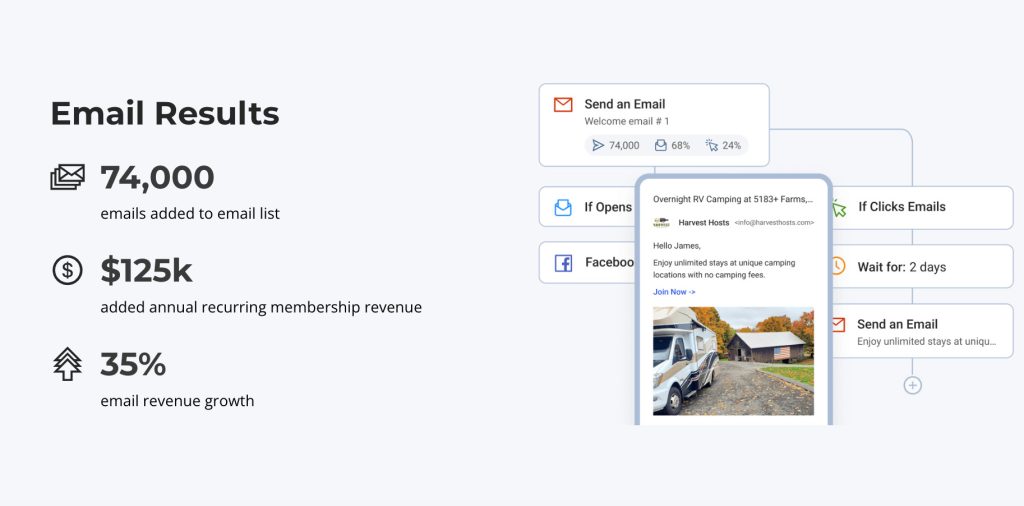
Triple Whale
Triple Whale, a DTC analytics platform, used website visitor identification software to improve their customer acquisition efforts. By tracking visitor behavior and creating more personalized marketing strategies, they saw a major improvement in lead generation and customer engagement. This allowed them to scale faster and optimize their marketing spend more effectively.
Kineon & Step Labs
Kineon, a wellness brand, partnered with Step Labs to streamline their visitor identification process. By using data enrichment tools and customer journey tracking, they were able to improve their website conversions and retarget visitors with personalized ads. This combination of visitor identification and targeted retargeting resulted in significant growth for the brand.
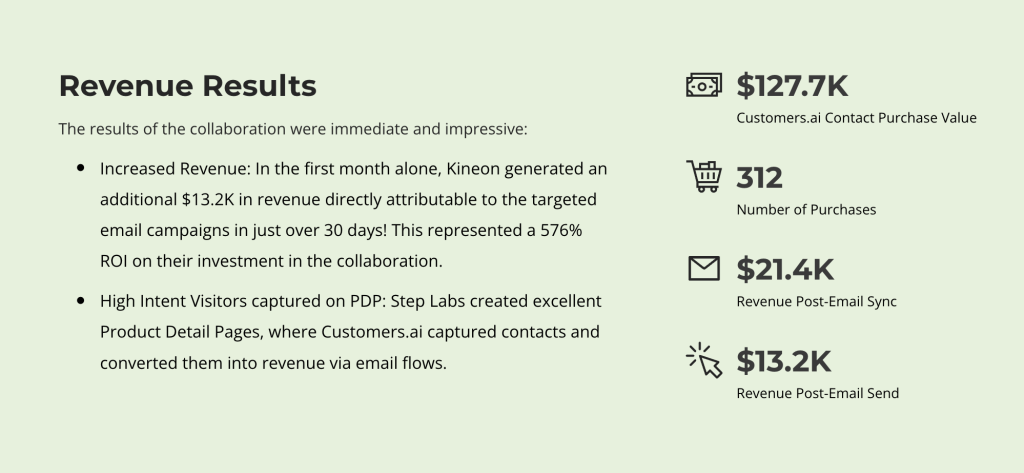

Website Visitor Identification Software & You
When it comes down to it, choosing the right website visitor identification software is all about finding the perfect fit for your ecommerce brand. You need a tool that seamlessly integrates with your existing platforms like Shopify and Klaviyo, gives you real-time insights, and lets you act on visitor data to turn browsers into buyers. With so many options out there, the key is making sure the software you choose doesn’t just collect data but helps you use it to drive results.
Whether you’re focused on reducing cart abandonment, improving retargeting efforts, or boosting conversions, the right visitor identification software can unlock big wins for your brand.
So take the time to evaluate what’s important for your business—whether it’s scalability, data privacy, or advanced customer journey tracking—and pick the tool that helps you turn insights into action.
If you are ready to give it a go or at least test it out, start your free trial today (no credit card required) and see how website visitor identification software can help your brand.

See Who Is On Your Site Right Now!
Get names, emails, phone numbers & more.
Try it Free, No Credit Card Required
Visitor Identification Software FAQs
Why do ecommerce brands need visitor identification software?
Ecommerce brands need visitor identification software to turn anonymous site traffic into actionable insights. By identifying visitors, ecommerce businesses can personalize their marketing efforts, reduce cart abandonment, and retarget high-intent customers to drive more conversions.
What are the key features to look for in visitor identification software?
When choosing visitor identification software, look for features like seamless integration with your existing tools (Shopify, Klaviyo), real-time data tracking, customer journey mapping, and strong data privacy compliance. The ability to segment and retarget visitors is also crucial.
What are the benefits of using website visitor identification software?
Benefits include identifying high-intent visitors, improving personalization in marketing, boosting retargeting effectiveness, reducing cart abandonment, and increasing overall marketing ROI. It helps ecommerce brands better understand their visitors and target them more effectively.
Can visitor identification software help with cart abandonment?
Yes, visitor identification software can track visitors who abandon their carts and help you retarget them with personalized ads or email campaigns. This enables ecommerce brands to re-engage those visitors and increase the chances of them completing their purchase.
What is the difference between IP tracking tools and visitor identification software?
IP tracking tools focus on identifying the company or general location of a visitor based on their IP address, which is more useful for B2B companies. Visitor identification software, on the other hand, is more advanced and helps ecommerce brands identify individual visitors and provide detailed profiles, making it more relevant for personalized marketing.
How do you integrate visitor identification software with Shopify or Klaviyo?
Most visitor identification software comes with built-in integrations for platforms like Shopify and Klaviyo. By connecting these tools, you can automatically sync visitor data to your CRM or email marketing platform, allowing you to segment and target visitors based on their behavior and shopping patterns.
Is website visitor identification software legal?
Yes, as long as it complies with data privacy regulations like GDPR and CCPA. It’s essential to ensure that your visitor identification software is transparent about data collection practices and allows visitors to opt in and out where necessary.
What is first-party data, and how does it relate to visitor identification?
First-party data is information that you collect directly from your site visitors, such as their email address, behavior on your site, and preferences. Visitor identification software enhances first-party data by providing more detailed profiles of your visitors and connecting that data to real people for personalized marketing.
How much does website visitor identification software cost?
Pricing for visitor identification software varies widely depending on the features and scale of the tool. Some platforms offer tiered pricing based on the number of visitors or data collected, while others offer flat-rate pricing. It’s important to choose a solution that fits your budget and scales with your business.
Can visitor identification software track returning visitors?
Yes, many visitor identification tools can recognize returning visitors by tracking cookies or integrating with your first-party data platforms like Shopify or Klaviyo. This helps ecommerce brands re-engage returning visitors with personalized offers or ads.
What’s the difference between visitor identification software and lead capture tools?
Visitor identification software focuses on identifying anonymous visitors and providing detailed data about them. Lead capture tools, on the other hand, are designed to collect contact information from visitors (such as via popups or forms). The two can work together to provide a fuller picture of your visitor engagement.
How can visitor identification software improve personalization in marketing?
By identifying anonymous visitors and providing insights into their behavior, visitor identification software allows ecommerce brands to create highly personalized marketing campaigns. This could include product recommendations, targeted ads, or personalized email follow-ups based on what the visitor has browsed or shown interest in.
How does visitor identification software help with retargeting?
Visitor identification software helps with retargeting by providing detailed visitor profiles. These profiles can be used to serve personalized ads to visitors across multiple channels, such as Facebook, Google, and Instagram, based on their behavior and interests on your website.
Is website visitor identification software only for ecommerce brands?
No, while ecommerce brands benefit greatly from visitor identification software, it’s also useful for B2B companies, SaaS businesses, and any organization that wants to understand its web traffic better and create personalized marketing efforts based on visitor data.
How accurate is website visitor identification software?
The accuracy of visitor identification software depends on the quality of the data it collects and the algorithms it uses to match anonymous visitors with known profiles. Tools that combine first-party data with third-party data typically offer higher accuracy and more reliable visitor profiles.
Can visitor identification software integrate with Google Analytics?
Yes, many visitor identification platforms integrate with Google Analytics, providing a more detailed view of individual visitor behavior alongside broader traffic metrics. This can give ecommerce brands a more complete understanding of who is visiting their site and how they’re interacting with it.
How do I choose the right website visitor identification software for my business?
To choose the right software, consider your business’s specific needs—like whether you need real-time data, customer journey tracking, or advanced segmentation. Make sure the software integrates with your current tools, fits your budget, and complies with data privacy regulations.
What are the most common mistakes when using visitor identification software?
Common mistakes include failing to integrate the software with your existing tools, not using the data to create actionable marketing strategies, and neglecting to comply with data privacy regulations. Ensuring proper setup and actively using the insights the software provides will help you avoid these issues.
